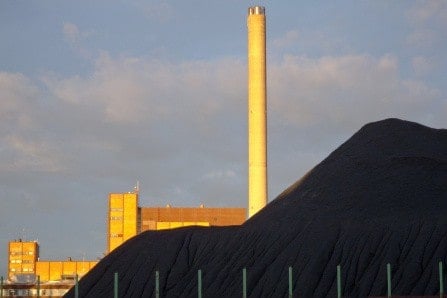Despite gains by natural gas, wind and solar, coal remains the top electricity producer in the United States.
Accordingly, interest is strong in developing technology that curbs unwanted effects, such as greenhouse gas emissions, that result from coal’s combustion.
To address the matter, the U.S. Department of Energy has awarded a $1.9 million grant to a research team led by the University at Buffalo. The researchers will develop a membrane to remove carbon dioxide, which makes up the vast majority of greenhouse gas emissions, from gasified coal before its combustion.
“The idea is to decarbonize coal before burning it,” said Haiqing Lin, PhD, the grant’s principal investigator and an assistant professor in the Department of Chemical and Biological Engineering at UB’s School of Engineering and Applied Sciences.
The grant is one of 16 announced last month by the energy department’s National Energy Testing Laboratory.
Lin will work with UB Distinguished Professor Mark T. Swihart, PhD, who serves as executive director of the New York State Center of Excellence in Materials Informatics. Also working on the project are Helios-NRG, LLC of Amherst, New York; Membrane Technology and Research, Inc. of Newark, California; and the National Carbon Capture Center in Wilsonville, Alabama.
“We are pleased to be working with UB on developing this exciting new technology which has the potential to make a step change in the economics of carbon capture from fossil-fueled power plants, thereby mitigating the nation’s emissions of greenhouse gases,” said Ravi Prasad, president at Helios, one of roughly two dozen high-tech startup companies in the UB Technology Incubator, which is administered by the university’s Office of Science, Technology Transfer and Economic Outreach (STOR).
While coal accounted for 39 percent of the nation’s electricity in 2014, it contributed 77 percent of the electricity sector’s carbon dioxide emissions, according to U.S. Energy Information Administration data. Because of coal’s abundance in the U.S. and abroad, researchers are exploring ways to capture, utilize and sequester carbon dioxide from the fossil fuel, a concept more commonly known as “clean coal.”
One way involves turning coal into a gas by reacting the fossil fuel at high temperatures with oxygen or steam. The result is a synthetic gas (syngas), containing mainly hydrogen and carbon dioxide, which can be used, among other things, to generate electricity.
Technology exists to remove the majority of carbon dioxide from syngas; however, the process makes it expensive compared to electricity derived from natural gas and other sources. The idea of using a membrane is appealing, Lin said, because it’s passive, and potentially more energy-efficient and less costly compared to other technologies.
The team will develop and test a polymer-based membrane outfitted with palladium-based nanoparticles. The polymers act as a filter, largely preventing the passage of carbon dioxide, while the palladium acts as a bridge that enables hydrogen gas to more easily pass through the membrane.
Theoretically, the hydrogen gas would pass through the membrane and then be burned, which in turn would power turbines. Meantime, the carbon dioxide could be geologically sequestered, used to create chemicals or pumped underground for enhanced oil recovery.
– See more at: http://www.buffalo.edu/news/releases/2015/09/011.html#sthash.KgOvLVAu.dpuf



I think that what you said was very logical. However, what about this?
what if you were to write a awesome headline? I ain’t saying
your information isn’t solid, however suppose you added something
that grabbed folk’s attention? I mean Filtering the carbon from coal – ScienceBlog.com is a little vanilla.
You should peek at Yahoo’s front page and see how they write article headlines to grab people to open the links.
You might add a related video or a related picture or two to grab people interested about everything’ve got to say.
In my opinion, it might make your website a little bit more interesting. https://betadeals.com.ng/user/profile/1636398
Energy is always conserved. Does the process require require more energy input than that available as syngas? Carbon reacting with oxygen to form CO2 releases energy. Just like burning coal. Stripping oxygen from H2O requires energy input. As in super heating steam. Which is greater?
This project is completely foolish if not insane. To de-carbonize coal is to make it something that has no thermal energy available for use.The very process of burning it to release energy by the use of oxygen to make C02 (carbon dioxide) is fundamental to its use. Looks like a huge excuse for providing some easy money to the university involved!
FINALLY…YES. But 1.9 million? sheesh… Billions spent on solar and wind…would have made far more sense to develop, near zero pollution, carbon fuel technology. We’d be light years ahead of the rest of the world with a product we could readily export.